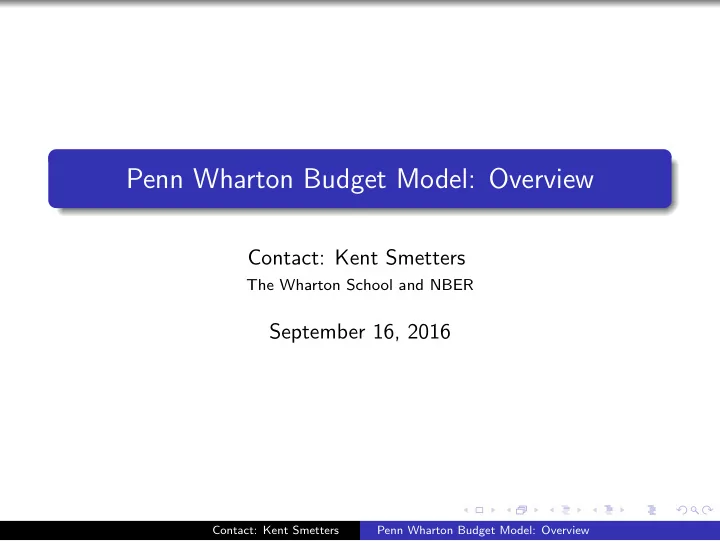

Penn Wharton Budget Model: Overview Contact: Kent Smetters The Wharton School and NBER September 16, 2016 Contact: Kent Smetters Penn Wharton Budget Model: Overview
Overview Combines modern advances of theoretical modeling, big data, Agile testing and development, cloud computing and dynamic visualization to solve challenging government budget questions: Static Model : Micro-simulation model that allows for a rich amount of heterogeneity and transitions Dynamic Model : Stochastic OLG model that creates “deltas” to sit on top of the micro-sim model. Data : A new data store combining large data sets at the household and aggregate level, used for model calibration Cloud Computing : Thousands of processors solving the economy across the entire set of policy combinations (e.g., for Social Security, 4,096 different policy combinations). Results stored on load-balanced JSON servers for immediate access. Visualization : Dynamic display reflects user choices Contact: Kent Smetters Penn Wharton Budget Model: Overview
Dynamic Model: Fundamentals Integrated with TPC static model, with only a few series coming from our static model for making debt calculations: Households make decisions about how much to work and save over their lifecycle, with overlapping generations. Decisions based on current and anticipated future economic conditions (such as uncertain wages, uncertain longevity, deterministic interest rates) and government policies Labor and capital markets determine the wages and the rental rate of capital that clear those markets. Shorter-term “Keynesian-like” effects: borrowing constraints (endogenous hand-to-mouth consumers) who immediately consume most of tax change; labor supply frictions, and a check for nominal wage rigidity (not binding for our purpose) Contact: Kent Smetters Penn Wharton Budget Model: Overview
Dynamic Model: Key Elements for Tax Reform Enhancements over many academic-like models: Unbalanced tax reforms: critical for understanding changes in marginal tax rates and concomitant changes in debt. International capital flows: can make different assumptions about how easily foreign capital flows. This feature and debt accumulation are key drivers. Dynamic deltas: results can be layered as “deltas” on top of micro-simulation results Deeper modeling of hybrid U.S. residential / territorial tax system Household side includes deductions, pass-through share of capital income, progressive tax schedule. Corporate tax is flat, territorial tax treatment with adjustable expensing. Contact: Kent Smetters Penn Wharton Budget Model: Overview
Calibration Model calibrated using a rich set of data sets: Current Population Survey (CPS) Panel Study of Income Dynamics (PSID) IRS Statistics of Income (SOI) SSA Public Use Files National Centers for Health Statistics Vital Statistics BEA Integrated Macro Accounts Federal Reserve, Survey of Consumer Finances Federal Reserve, U.S. Financial Accounts National Cancer Institute U.S. Mortality Data Bureau of Labor Statistics Contact: Kent Smetters Penn Wharton Budget Model: Overview
Dial Controls User can vary key behavioral assumptions Contact: Kent Smetters Penn Wharton Budget Model: Overview
Most important setting: Foreign Investment Open Economy Contact: Kent Smetters Penn Wharton Budget Model: Overview
Most important setting: Foreign Investment Open Economy Contact: Kent Smetters Penn Wharton Budget Model: Overview
Most important setting: Foreign Investment Closed Economy Contact: Kent Smetters Penn Wharton Budget Model: Overview
Most important setting: Foreign Investment Closed Economy Contact: Kent Smetters Penn Wharton Budget Model: Overview
Most important setting: Foreign Investment Closed Economy Contact: Kent Smetters Penn Wharton Budget Model: Overview
Most important setting: Foreign Investment Baseline Economy (40%) Contact: Kent Smetters Penn Wharton Budget Model: Overview
Most important setting: Foreign Investment Why our Default Choice of 40%? Contact: Kent Smetters Penn Wharton Budget Model: Overview
Most important setting: Foreign Investment Contact: Kent Smetters Penn Wharton Budget Model: Overview
Why capital fails to flow more? Feldstein and Horoika (1980): “home bias” (e.g., different legal structures, investing in what you know, etc.) producing a reluctance to diversify financial portfolios across countries Obstfeld and Rogoff (2000): Home bias declined over time, but it still remains high. Today: foreign entities (individuals, corporations, and governments) hold only 18.5% of total financial securities issued by U.S. domestic sectors (including federal, state, and local governments). So, our 40% value is probably generous Moreover, no free lunch: more capital flows implies more foreign capital stock ownership Contact: Kent Smetters Penn Wharton Budget Model: Overview
Future Work Will soon add more detail to website breaking down national income and tax revenue by source (working hard to line up with TPC definitions) Add adjustment costs and other features Clinton and Trump, to be released Contact: Kent Smetters Penn Wharton Budget Model: Overview
Main Takeaway New Versus Old Capital Business investment has indeed declined in U.S. Also, U.S. corporate statutory rate is higher than other developed countries. Tax plan above attempts to “doubly encourage” capital investment by increasing expensing (bonus depreciation) and by reducing the corporate income tax rate. But, these two features actually work in opposite directions for stimulating the economy in our model. Contact: Kent Smetters Penn Wharton Budget Model: Overview
Main Takeaway Expensing Expensing is a powerful mechanism for stimulating new investment, as it applies only to new capital Full expensing implies new investment pays no taxes in present value (unless there are rents, which could be efficient to tax) Unless adjustment costs are high, existing capital takes a hit. In math: Tobin’s q = 1 − τ k ∗ Z , where Z is the expensing rate and τ k is the corporate tax rate Increasing Z alone lowers q , which is an efficient lump-sum “wealth tax” used to reduce future tax rates. Lowering τ k at the same time is like wearing two pairs of (costly) socks: new capital is already effectively untaxed as Z approaches 1. So, lowering τ k just rewards existing capital, increasing deficits. Biggest bang for buck (Bradford’s X tax): set Z = 1 (full expensing) while setting τ k at highest marginal PIT rate. Contact: Kent Smetters Penn Wharton Budget Model: Overview
Recommend
More recommend